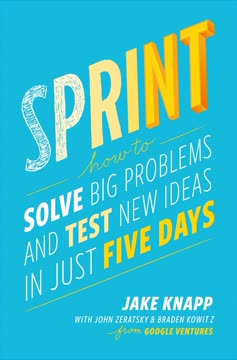Key Takeaways
1. Project management is a structured approach to achieving specific goals within constraints
Quality = Time + Cost
The project management triangle. Successful projects balance three key constraints: time, cost, and quality/scope. Changing any one variable impacts the others. For example, reducing time often requires increased costs or reduced quality. Project managers must make tradeoffs between these factors based on stakeholder priorities and project goals.
Phases of project management. Most projects follow four main phases:
- Planning: Defining objectives, scope, tasks, and resources
- Build-up: Assembling the team and creating detailed schedules
- Implementation: Executing tasks and monitoring progress
- Closeout: Evaluating results and capturing lessons learned
Effective project management requires adapting approaches based on the level of uncertainty. For predictable projects, traditional planning works well. For innovative projects with many unknowns, adaptive methods using short cycles and frequent re-planning are more suitable.
2. Effective planning sets the foundation for project success
SMART objectives should be: Specific, Measurable, Action-oriented, Realistic, Time-limited
Define clear objectives. Ambiguous goals lead to misunderstandings and disappointment. Work with stakeholders to establish specific, measurable objectives that align with business needs. Break down high-level goals into concrete deliverables and milestones.
Create a detailed project plan. Key planning tools include:
- Work Breakdown Structure (WBS): Hierarchical decomposition of project tasks
- Critical Path Method (CPM): Identifies sequence of critical activities
- Gantt charts: Visual timeline of tasks and dependencies
- PERT charts: Network diagram showing task relationships
Involve the team in planning to gain buy-in and surface potential issues early. Be prepared to revise plans as new information emerges during the project.
3. Building a cohesive team is critical for project execution
Mutual accountability leads to astonishing results.
Assemble the right mix of skills. Look beyond just technical expertise when forming your team. Consider problem-solving abilities, interpersonal skills, and organizational knowledge. Aim for diversity in perspectives and backgrounds.
Foster team cohesion. Strategies for building a high-performing team:
- Hold a kickoff meeting to align on goals and expectations
- Establish clear roles and responsibilities
- Create shared norms and ground rules
- Encourage open communication and constructive debate
- Celebrate milestones and team successes
Effective teams develop mutual accountability, where members feel responsible not just to the leader, but to each other. This drives higher performance than individual accountability alone.
4. Implementation requires constant monitoring and adaptation
Respond quickly to changes in data or information as they come in, and look for early signs of problems so you can initiate corrective action.
Track progress rigorously. Use regular check-ins, progress reports, and project management software to monitor task completion, budget utilization, and overall project health. Pay special attention to critical path activities that could delay the entire project if not completed on time.
Adapt plans as needed. Few projects go exactly as planned. Be prepared to adjust schedules, reallocate resources, or modify deliverables based on new information or changing circumstances. When making changes:
- Assess impact on project objectives and constraints
- Communicate clearly with stakeholders
- Document decisions and rationale
- Update project plans and schedules accordingly
Balance flexibility with maintaining focus on core project goals. Not every suggested change needs to be implemented.
5. Communication is key throughout the project lifecycle
Stakeholders will generally want regular updates and status reports. Consult with them to see how much information they'd like and in what format.
Tailor communication to your audience. Different stakeholders have different information needs:
- Executives: High-level progress, risks, and business impact
- Team members: Detailed task assignments and dependencies
- Clients/end users: Milestones and how changes affect them
Use a mix of communication methods:
- Regular status meetings and reports
- Project dashboards or scorecards
- Email updates for time-sensitive information
- Informal check-ins to surface issues early
Be transparent about both successes and challenges. Building trust through open communication makes it easier to navigate difficult situations when they arise.
6. Manage risks and changes proactively to stay on track
Don't hide or downplay problems as they come up, or you can easily transform them into crises.
Identify and plan for risks. Conduct a thorough risk assessment at the start of the project and regularly reassess throughout. For each significant risk:
- Estimate probability and potential impact
- Develop mitigation strategies
- Assign an owner to monitor and respond
Establish a change control process. As new requirements or opportunities emerge:
- Evaluate impact on project constraints (time, cost, quality)
- Get stakeholder approval for significant changes
- Update project plans and communicate to the team
Stay alert for scope creep - gradual expansion of project boundaries without corresponding adjustments to resources or timelines. Learn to say no to non-essential changes that could jeopardize core objectives.
7. Learn from both successes and failures to improve future projects
Success breeds success.
Conduct a formal lessons learned session. Gather the team to reflect on what went well and what could be improved. Focus on actionable insights rather than assigning blame. Key questions to explore:
- Did we achieve our objectives? Why or why not?
- What unexpected challenges did we face?
- Which processes or tools were most/least effective?
- How well did we collaborate as a team?
Document and share learnings. Capture key takeaways in a format that's easy for future project teams to reference. This might include:
- Updated templates or checklists
- Best practices and pitfalls to avoid
- Recommendations for process improvements
Celebrate team accomplishments, even if the project faced setbacks. Recognizing effort and progress motivates people to apply lessons learned to future work.
Last updated:
FAQ
What's "HBR Guide to Project Management" about?
- Comprehensive Guide: The book is a comprehensive guide to managing projects effectively, providing tools and strategies for project managers at all levels.
- Four Phases: It outlines the four phases of project management: planning, build-up, implementation, and closeout, detailing the activities and skills needed for each phase.
- Practical Advice: The guide offers practical advice on choosing the right team, avoiding scope creep, and using tools like Gantt and PERT charts.
- Expert Contributions: It includes insights from leading experts and case studies to illustrate real-world applications of project management principles.
Why should I read "HBR Guide to Project Management"?
- Trusted Source: The guide is published by Harvard Business Review, a trusted brand in business education, ensuring high-quality content.
- Skill Enhancement: It helps enhance your project management skills, making you more effective in leading projects and achieving goals.
- Problem-Solving: The book addresses common project management challenges and provides solutions to overcome them.
- Career Advancement: By mastering the techniques in this guide, you can improve your career prospects and become a more valuable asset to your organization.
What are the key takeaways of "HBR Guide to Project Management"?
- Phased Approach: Understand the importance of managing projects through distinct phases, each with specific tasks and objectives.
- Stakeholder Management: Learn how to identify and manage stakeholders effectively to ensure project success.
- Scope and Flexibility: Gain insights into setting project scope and knowing when to be flexible to accommodate valuable changes.
- Lessons Learned: Emphasize the importance of capturing lessons learned to improve future project management practices.
How does the book define the four phases of project management?
- Planning Phase: Focuses on defining the project’s objectives, scope, and resources, and identifying stakeholders.
- Build-Up Phase: Involves assembling the team, planning assignments, and creating a schedule and budget.
- Implementation Phase: Centers on executing the project plan, monitoring progress, and managing any issues that arise.
- Closeout Phase: Entails evaluating project performance, capturing lessons learned, and formally closing the project.
What is "scope creep" and how does the book suggest managing it?
- Definition: Scope creep refers to the uncontrolled expansion of project scope without adjustments to time, cost, and resources.
- Planning: The book advises setting clear project boundaries and involving stakeholders in defining the scope.
- Change Control: Implement a change control process to evaluate and approve any changes to the project scope.
- Communication: Maintain open communication with stakeholders to manage expectations and prevent unauthorized changes.
What tools does the "HBR Guide to Project Management" recommend for scheduling?
- Gantt Charts: Useful for visualizing the project timeline and tracking progress against the schedule.
- PERT Charts: Help in identifying task dependencies and the critical path to ensure timely project completion.
- Critical Path Method (CPM): A technique to identify the sequence of crucial tasks that determine the project duration.
- Draft Schedule: Start with a draft schedule and optimize it by identifying bottlenecks and reallocating resources as needed.
How does the book suggest handling project meetings effectively?
- Purpose and Agenda: Clearly define the meeting’s purpose and provide an agenda in advance to keep discussions focused.
- Participation: Invite only those who can contribute or benefit from the meeting, ensuring productive discussions.
- Follow-Up: Summarize outcomes and action items post-meeting to reinforce decisions and maintain momentum.
- Inclusivity: Encourage participation from all attendees to gather diverse perspectives and foster team collaboration.
What is the "adaptive approach" to project management mentioned in the book?
- Iterative Process: The adaptive approach involves iterative cycles of planning, executing, and evaluating to manage uncertainty.
- Fast Cycles: Emphasizes short lead times and early value delivery to incorporate feedback and learning into the project.
- Flexible Staffing: Staff projects with adaptable individuals who can respond to changes and learn quickly.
- Venture Capital Model: Sponsors support projects in stages, similar to venture capitalists, to reduce uncertainty and manage risks.
What are some common reasons for project failure according to the book?
- White Space: Gaps in the project plan where necessary activities are overlooked.
- Execution Issues: Team members fail to carry out tasks properly, leading to delays and quality issues.
- Integration Failure: Even when tasks are completed, the project fails to deliver intended results due to poor integration.
- Scope Creep: Uncontrolled changes to the project scope that disrupt timelines and budgets.
How does the book recommend capturing lessons learned from a project?
- Formal Sessions: Conduct formal lessons-learned sessions or postmortems to document insights and improvements.
- Continuous Improvement: Use the lessons to refine project management processes and enhance future project performance.
- Team Involvement: Involve the entire team in identifying what worked well and what didn’t to gain diverse perspectives.
- Documentation: Record lessons in a centralized location for easy access and reference by future project teams.
What are the roles and responsibilities of a project manager as outlined in the book?
- Problem Identification: Define the central problem and determine project objectives and scope with input from stakeholders.
- Planning and Scheduling: Develop and oversee the project plan, schedule tasks, and allocate resources effectively.
- Monitoring Progress: Track project activities, manage risks, and ensure the project stays on track to meet objectives.
- Team Leadership: Coordinate team activities, mediate conflicts, and ensure all members contribute to project success.
What are the best quotes from "HBR Guide to Project Management" and what do they mean?
- "Defining the problem first gives you greater degrees of freedom in solving it." This emphasizes the importance of understanding the core issue before jumping into solutions, allowing for more creative and effective problem-solving.
- "Success means achieving the goals in your charter and scope statement—not necessarily finishing all the tasks on your Gantt chart." Highlights the focus on achieving project objectives rather than merely completing tasks.
- "The purpose of teams is not to meet and discuss. It’s to act and produce results." Stresses the action-oriented nature of project teams, where the ultimate goal is delivering tangible outcomes.
- "Don’t get hung up on compliance with the original plan." Encourages flexibility and adaptability in project management to achieve the best results.
Review Summary
HBR Guide to Project Management receives mixed reviews, with an average rating of 3.79 out of 5. Many readers find it a good introduction to project management, praising its concise and practical approach. It's particularly helpful for beginners or those seeking a refresher. The book covers project phases, offers useful frameworks, and includes real-life examples. Some experienced project managers find it too basic, while others appreciate its value as a quick reference. Readers highlight its clarity, organization, and applicability to various industries.
Similar Books








Download PDF
Download EPUB
.epub digital book format is ideal for reading ebooks on phones, tablets, and e-readers.













